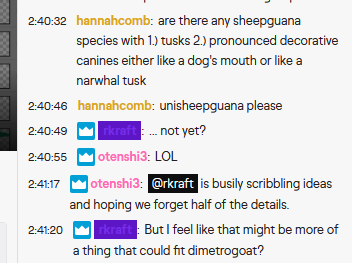
One of the stranger breeds of this strange species of livestock is the McGill dimetrogoat. While it was first bred in the north-western coastal plains, small flocks can now be found in many places all across the continent.
A typical meat-breed adapted to flat temperate regions, the McGill has a stocky body with relatively short legs and tail. Its scales are bright yellow, darkening to light brown in old age to match its coat. The sail shows faint hexagonal markings but is otherwise small and fleshy, with the meat of the back reaching about halfway up the spines in a well fed individual.
Still, the McGill’s most prominent distinguishing feature is the third ‘horn’ growing from its snout. For this reason bards and other persons who wish to appear more learned than they are will sometimes call the McGill the ‘tricerate’ dimetrogoat. All this does, however, is unmask them as the witless fools they are, for although it may seem to be a horn to the casual observer, this facial adornment is in fact a tooth that has grown in a most peculiar manner and is therefore more properly called a tusk.
Specifically, it is the left upper canine which, instead of growing downward from the skull, has shifted towards the front of the premaxillary bone and grows outwards to emerge through the lip just below the left nostril, giving the animal its distinctive silhouette while the single remaining canine tooth lends the animal’s mouth a slightly lopsided appearance. The tusk grows straight out at a slight upward angle from the head but twists on itself to take on a spiral shape. While it is sometimes used in fighting off rivals and predators and plays a certain role in dominance and mating displays, the tusk’s primary purpose is to serve as a tool for foraging. It is quite sensitive and is used both in poking through snow, rocks or leaf litter and in finding and digging for roots and small vertebrates.
Similarly to the incisors of rodents, the tusk grows continually throughout the animal’s life. With the normal wear of living in a pasture, its length will roughly keep pace with the beast’s horns, measuring about two to three feet at slaughtering age and reaching up to five feet in animals kept for breeding stock.
The tusk normally takes on the same yellowed shade typical for mammalian teeth, but with careful grooming and cleaning it will remain a bright pearlescent white that sometimes glows faintly with the animal’s latent magic. Due to the large amount of labour involved, this is only done for small flocks of display animals, such as those kept by the monastery of the Quailadin order of St. Thymes, which features them on its coat of arms, as well as a few noble houses and merchant families.
These animals are usually kept in paddocks with hard ground and fed from troughs to prevent the wear and discolouration caused by digging, but the conscientious guardian will make sure that the paddock also includes a sizeable pit of fine sand and other ways to allow the animal to express natural behaviour. If suitable sand is chosen, it can serve to help in polishing the tusk to a high shine and special treats buried in the sand or hidden in hollowed out logs will keep the animals active, maintaining their good health and agreeable temper. Without such enriching activities, they will become vulnerable to parasites and disease and may become skittish or aggressive when exposed to the bustle and noise of the festivities and religious ceremonies they are typically shown at, leading to unfortunate occurrences such as the infamous shish-kabishop incident that left several major temples without leadership and for which the followers of St. Thymes are doing penance to this day.
The McGill is primarily kept for meat production as it gains muscle quickly and its meat has the distinctive flavour caused by the dimetrogoat’s omnivorous diet. Its coat is of no commercial value but can be spun into yarn or felted for the use of the guardian. The tusks are a valuable source of ivory and longer examples are sometimes made into elaborately carved walking sticks or even wands. The immaculate teeth of display animals are highly sought after by artisans as well as by travelling bards and other miscreants who will try to pass them off as genuine unicorn horns.
Dimetrogoat was invented during @Hannahcomb ‘s Halloween stream last year.
The McGill breed was inspired by this exchange during one of @SarahWithTea ‘s Friday Teatime streams.
